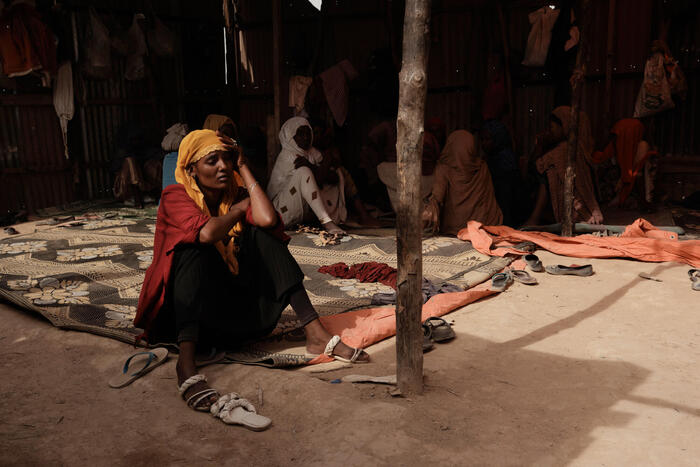
Growing number of women and girls migrating via perilous Eastern Route

Situated at a strategic maritime point in the Horn of Africa, Bosaso serves as one of the last stops for those seeking to leave the region via the Eastern Route – a migratory path that continues through Yemen and leads to the Gulf States.
Migrant women often recount despair and horror for the harassment and abuse they have experienced along the Eastern Route – from falling victim to forced marriages with smugglers, who exploit them for financial gain and trap them in unending cycles of abuse, to being trafficked into situations of exploitation while searching for job opportunities in the Middle East.
Although the majority of those taking the Eastern Route are men, the number of women has doubled over the past two years, from 53,000 in 2021 to 106,700 in 2022.
Yasmine, a 14-year-old Ethiopian girl, left home due to problems in her family, hoping to find a better life somewhere else. She fell victim to traffickers who held her captive in a house in Las Anod for more than five months, as her family could not pay the ransom to secure her release. Smugglers and traffickers frequently use force and threats to extort money from migrants in cities of transit.
Eventually, her captors grew tired of her. "They let me go when I fell ill and they could no longer use me,” she explains.
A passerby found her in the city of Burao as she was trying to return to Ethiopia by foot. He took her to a charitable organization that helps migrants in distress.
The International Organization for Migration (IOM) provides services for migrants, including potential victims of trafficking, through migrant response centres (MRCs) in Bosaso and Hargeisa.
According to Fariida Musse, a staff member at Bosaso's MRC, many women who visit the centre have been held hostage for several months. "Dozens of pregnant women come here alone and don't know what to do with their babies.”
The centre provides free medical care, water, food, and information. The staff also registers migrants who wish to return home and refers vulnerable cases to other safe houses where they can receive more tailored care and consider their options.
But as the risk of trafficking and exploitation rises, the funding to assist vulnerable migrants and victims is decreasing, which is felt by migrants, including women and girls, along the Eastern Route.
The organization where Yasmine was taken – known as the Ethiopian Community Centre – relies on contributions from local communities to carry out its humanitarian work. IOM used to support their activities, but due to limited funding had to stop last year.
Despite this setback, the centre’s staff covered Yasmine’s bus fee to Hargeisa using their own money and advised her to visit Hargeisa's MRC. Yasmine's whereabouts upon arrival in Hargeisa are unknown. Neither IOM nor the community were able to locate her.
According to IOM Chief of Mission in Somalia, Franz Celestin, adequate funding to support migrants could have prevented situations like Yasmine’s.
"We could have had someone accompany her on the trip back to ensure she had access to the assistance she needed after such a traumatic event.”
IOM works with local authorities in the Horn of Africa to strengthen anti-trafficking mechanisms and awareness-raising campaigns to make migration safer in the region. But funding for these activities is limited.
Despite the dangers of the Eastern Route, many migrants make it to Yemen, and some manage to reach the Kingdom of Saudi Arabia. Their situation, however, remains dire.
IOM estimates there are 43,000 migrants trapped in Yemen, living in precarious conditions and at risk of getting caught in the ongoing conflict.
IOM has been playing a key role in supporting migrants in need of safe and voluntary repatriation through charter flights and in-land transportation. The Organization has also developed reintegration initiatives that help those who return to restart their lives with dignity.
"Migrants who returned home, thanks to our programme, have received skills training, education courses, grants and medical support,” says Celestin, which also highlights how these initiatives address the root causes of irregular migration by giving people alternatives. "If people had opportunities, they wouldn’t be risking their lives and traffickers couldn’t take advantage of them.”
Since early 2022, IOM has supported more than 5,700 stranded migrants and victims of trafficking to safely return to their home countries from Yemen. Approximately 300,000 vulnerable migrants have also benefited from humanitarian assistance in Yemen, Somalia, and Djibouti. So far in 2023, IOM assisted 5,631 migrants, including 5,572 Ethiopians, to return home on Voluntary Humanitarian Return (VHR) flights.
IOM is now appealing for USD 58.5 million through the Migrant Response Plan (MRP) to continue this vital support in the region.
Text by Claudia Rosel.
All testimonies were collected between August 2022 and June 2023.
Leave a comment
- Popular
- Rated
- Commented
04/11/2021 - 11:05:02
12/03/2023 - 22:58:08
22/01/2023 - 11:24:06
13/12/2015 - 09:27:08
01/03/2021 - 09:00:37
Opinions
30/04/2024 - 01:33:18
17/04/2024 - 22:46:39
08/03/2024 - 02:04:01
Politics
02/05/2024 - 23:52:49
30/04/2024 - 01:33:18
22/04/2024 - 15:18:30
Terror Watch
05/05/2024 - 01:52:29
05/05/2024 - 01:47:23
Press Releases
30/04/2024 - 22:03:16
18/04/2024 - 21:29:03
 0
0 


































Growing number of women and girls migrating via perilous Eastern Route
Bosaso, Somalia – In the early morning hours, more than 30 young women and girls, and at least a dozen men are gathered in a precarious settlement on the outskirts of Bosaso, in northern Somalia. Some lie directly on the floor, others on top of